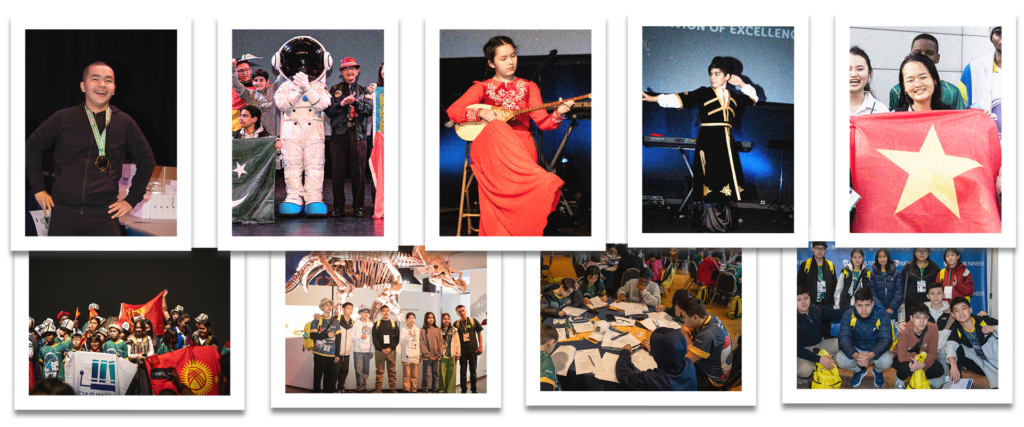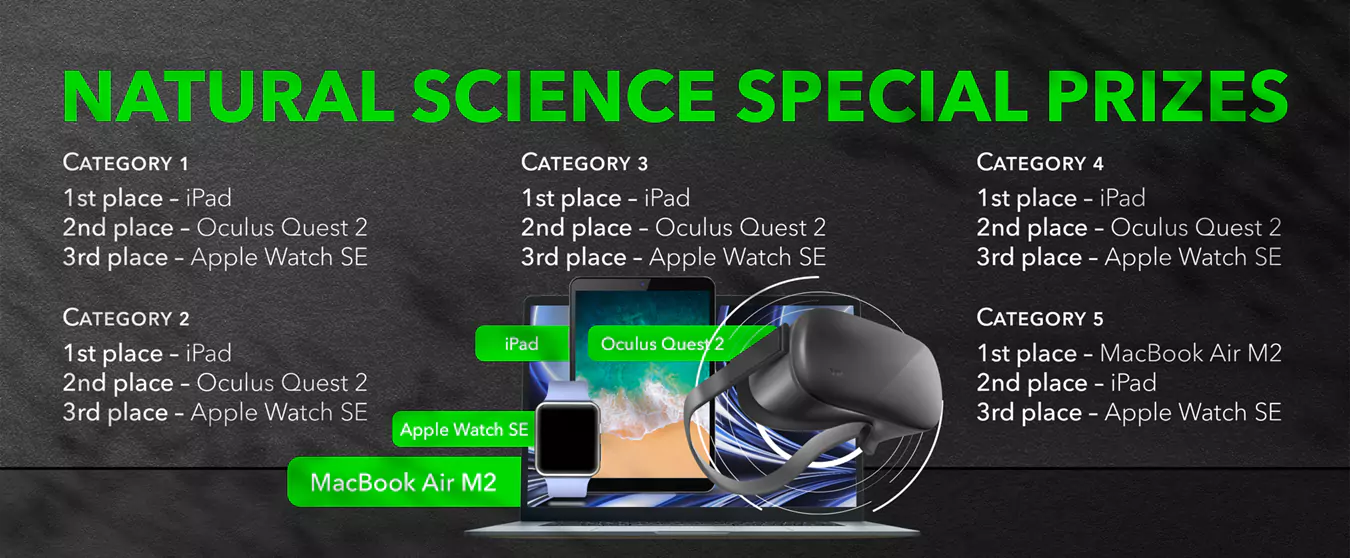
Natural Science Olympiad
Introducing Natural Science Olympiad
In this modern day wherein technology advances and artificial intelligence thrive, it is important to continue to hone the science concepts among our students. It is to further develop their critical thinking, problem-solving skill, and innovativeness. This is the main goal of Copernicus’ Natural Science Olympiad – to provide a venue for students to test their knowledge on natural science, engage in decision making, and learn how to apply skills in a real-life context.
The Natural Science Olympiad focuses on Natural science, a science that involves understanding, prediction, and description of natural phenomena. Natural science can be divided into two main branches: life science and physical science. Life science is alternatively known as biology, and physical science is subdivided into branches: physics, chemistry, earth science, and astronomy.
Natural science entails an in-depth study of the natural phenomena and therefore helps students to learn concepts required to understand the natural world. With such understanding, students can solve existing problems and also come up with inventions. Focusing natural science is vital as it helps students acquire analytical and critical thinking skills as they understand the natural world.
In the Preliminary Round, medals will be awarded based on the following percentages:
- The Copernicus Natural Science Olympiad is an international event that is open to students from Grade 3 to 12.
- It is divided into two rounds – the Preliminary Round and the Global Round.
- Students can register to the event through an online registration via Copernicus Olympiad website or via official country representatives.
- All registered participants will take the online qualifying exam for the Preliminary Round which will be held on September 28 and November 2 , 2024.
The online qualifying exam has 25 multiple choice questions that will be administered for 60 minutes. Students must choose the online qualifying exam from the Category they belong to. The groupings are as follows:
- Category 1 – Grade 3 and 4
- Category 2 – Grade 5 and 6
- Category 3 – Grade 7 and 8
- Category 4 – Grade 9 and 10
- Category 5 – Grade 11 and 12
Life Science |
Physical Science |
|---|---|
• Anatomy • Botany • Cytology • Ecology • Genetics and evolution • Microbiology • Taxonomy • Zoology |
• Astronomy • Chemistry • Earth Science (i.e., Geology, Meteorology, Oceanography) • Physics |
- Students who get at least 40% in the Preliminary Round become eligible to participate the Global Round.
- Regardless of score, all participants of Preliminary Round will receive a Certificate of Participation.
- Students who qualify for the Global Round will be awarded with a Certificate of Achievement and a medal according to the score they got in the Preliminary Round exam.
In the Preliminary Round, medals will be awarded based on the following percentages :
- 40% to 49% – Honorable Mention Certificate
- 50% to 74% – Bronze Medal
- 75% to 90% – Silver Medal + 5% off in the Global Round registration fees
- 91% to 100% – Gold Medal + 10% off in the Global Round registration fees
- Qualifiers to the Global Round must register again to the website or through official country representatives to indicate important travel documentation.
- The Global Round will be held between January 5 and 10, 2025 in Houston, Texas.
- The Global Round exam is a combination of exam, interactive challenges, and tour quizzes.

- The Global Round Exam consists of 25 multiple choice questions about Natural science, with subcategories similar to the Preliminary Round.
- The Interactive Challenges are as follows:
- Problem-Solving Challenge is a set of different scientific games and puzzles to feed the interests of the young minds. It is basically a fun and exciting segment during the event, with the application of the learning in different fields of science.
- On-the-Spot Challenge is the part of the competition that is composed of impromptu challenges that may range from simple essay writing and slogan making to experiment designing and science journalism. To become a true scientist, one does not simply perform the experiment; one must also be open-minded and be engaged in critical thinking about present issues, towards communicating the findings. Thus, this workshop provides another venue for attaining the fullness of being a scientist.
Note that students have an option to do the interactive challenge individually or by team. There could only be a maximum of 3 students per team and students must belong to the same grade level groupings. Should students decide to group together, their team score will be their individual score at the end of the challenge.
- The Tour Quizzes are 5 to 10 item questions that students will answer as they visit various educational places as part of the Natural Science Olympiad tour package.
- To determine the winners, scores of participants for each round will be gathered and computed based on the given percentages. Take note that scores will be computed individually.
- Global Round Exam = 80%
- Interactive Challenges = 10%
- Tour Quizzes =10%
- Total = 100%

- In the Global Round, medals will be awarded based on the following percentages:
- The top 10% will receive a Gold Medal.
- The next 11-30% will receive a Silver Medal.
- The next 31-60% will receive a Bronze Medal.
- The next 61-75% will receive an Honorable Mention Certificate.

Syllabus |
Life Science |
Physical Science |
|---|---|---|
Category 1 (Grade 3 and 4)
|
• Characteristics of living things • Basic needs of living things • Structures and functions of plants • Structures and functions of animals • Parts and functions of the human body • Major organs of the human body • Classification of animals – vertebrates and invertebrates • Basic plant and animal adaptations to their environment • Simple food chain • Roles in ecosystem – producers, consumers, decomposers |
• Definition of matter • Classification of matter • Characteristics of solid, liquid, gases • Sorting objects as solid, liquid, gases • Measuring volume and mass • Definition of force • Effects of force on matter • Definition of energy • Types of energy – potential and kinetic • Forms of energy • Types of weather • Members of the solar system |
Category 2 (Grade 5 and 6)
|
• Human body systems – parts and functions • Basic parts and functions of the cell • Comparing prokaryotes and eukaryotes • Plant reproduction – natural and artificial • Reproductive parts of the plants • Seed germination • Life cycle of plants • Animal reproduction – internal and external reproduction • Life cycle of animals (i.e., insects, frog, mammal) • Complete and incomplete metamorphosis • Behavioral and structural adaptations of plants and animals • Classification of animals based on the food they eat • Food chain and food web • Nutrient cycle (carbon, water, oxygen, nitrogen) |
• Basic structure of an atom • Subatomic particles • Atom vs molecule • Element vs compound • Physical and chemical properties of matter • Physical and chemical changes in matter • Motion in one dimension • Speed vs velocity • Distance vs displacement • Acceleration • Transformation of energy • Energy sources • Heat vs temperature • Circuits • Phases of the moon • Seasons and tides • The Milky Way • Types of galaxies • Minerals and rocks • Rock layers and soil formation |
Category 3 (Grade 7 and 8)
|
• Levels of biological organization • Human body systems – parts, functions, and interactions • Cell structure and function • Cell theory • Comparing plant and animal cells • Vascular and nonvascular plants • Angiosperm and gymnosperm • Levels of ecological organization • Biotic and abiotic factors of ecosystem • Food chain, food web, and transfer of energy in ecosystem • Interactions in ecosystem (symbiotic and non-symbiotic relationships) • Microorganisms – bacteria, fungi, and protists • History of life and earth formation (different eras) |
• Classification of matter – pure substances and mixtures • Phase changes • The Periodic Table of Elements • Chemical symbols and formulas • Law of conservation of mass • Two-dimensional motion • Newton’s laws of motion • Work, power, and energy • Transformation of energy (potential to kinetic and vice versa) • Magnetism • Rock cycle • Types of rocks • Weathering, erosion, and deposition • The Universe |
Category 4 (Grade 9 and 10)
|
• Human body systems – illnesses affecting organs • Human reproduction • Cell cycle • Cell division – mitosis and meiosis • Prokaryotes and viruses • Energy pyramid and trophic levels • Carrying capacity and limiting factors • Factors affecting the population in an ecosystem • Biodiversity and sustainability • Mendel’s experiments • Laws of inheritance (Mendelian and non-Mendelian • Human genome and chromosome • Punnett square – monohybrid and dihybrid cross • Genetic disorders |
• Atomic theory • Isotopes and average atomic mass • Chemical reactions • Parts of a chemical equation • Balancing a chemical equation • Momentum • Newton’s law of gravitation • Waves and energy • Electromagnetic waves • Electromagnetism • Optics • Fossilization • History of earth – ice cores • Stars • The Big Bang Theory |
Category 5 (Grade 11 and 12)
|
• Human body systems – homeostasis and feedback mechanisms • Cell mutation • Central dogma of molecular biology (DNA – structure and replication) • Genetic engineering and ethical issues in biotechnology • Biomolecules (carbohydrates, lipids, proteins, nucleic acids) • Polymers • Invertebrate diversity, evolution, and classification • Vertebrates’ diversity, evolution, and classification • Phylogeny and cladistics • Theory of evolution and natural selection • Forces of evolution • Population genetics |
• Scientific notation and significant figures • Accuracy and precision • Dimensional analysis • Valence electrons • Electron configurations • Chemical bonding • Endothermic and exothermic reactions • Redox reaction • Chemical nomenclature • The Special Theory of Relativity • Kepler’s law • Laws of stratigraphy • Relative and absolute dating (computing half-life) • Expansion of universe • Dark matter |